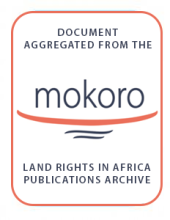Land Library Search
Through our robust search engine, you can search for any item of the over 73,000 highly curated resources in the Land Library.
If you would like to find an overview of what is possible, feel free to peruse the Search Guide.
/ library resources
Showing items 37 through 45 of 208.While academics have largely shifted their focus from ‘women in development’ to addressing women and men as
part of broader ‘gendered’ social relations, this shift is yet to be fully translated into development practice. This
Up to 2.5 billion people depend on indigenous and community lands, which make up over 50 percent of the land on the planet; they legally own just one-fifth. The remaining land remains unprotected and vulnerable to land grabs from more powerful entities like governments and corporations.
The eradication of hunger and poverty largely depend on how people, communities and others gain access to land. The livelihoods of many, particularly the rural poor including women, are based on secure and equitable access to and control over land and other natural resources.
Land Economics/Use,
A case study of the situation in Lamu, Isiolo and Siaya Counties by the Land Development and Governance Institute (LDGI).
"Decentralized approaches to development are gaining increasing prominence. Land tenure reform policy has been affected by many different types of decentralization. However, the literature on land tenure reform rarely explicitly addressed the implications of decentralization, and vice versa.
This paper focuses on the establishment of forest plantations on bare lands and marginal agricultural lands: a multifunctional afforestation programme for Ukraine is elaborated. The multiple forest functions are limited in this research to wood production and erosion prevention.
This note provides guidance for businesses to identify and address legacy land issues in agricultural investments.


